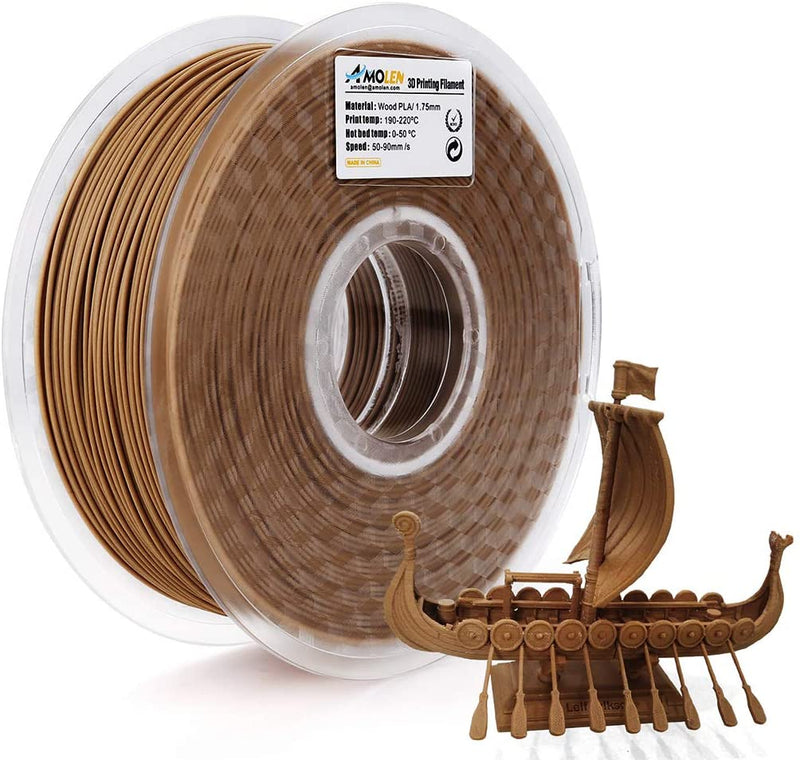Unlock the Secret to Wooden Wonders: Discover the Magic of Wood-Like PLA Filament for 3D Printing!
In the fascinating world of 3D printing, PLA filament has emerged as a favorite among enthusiasts and professionals alike. This biodegradable plastic, derived from renewable resources like corn starch, offers a user-friendly experience for those venturing into the realm of additive manufacturing. Among the various types of PLA, wood-like PLA filament is gaining traction for its unique ability to mimic the appearance and texture of real wood. This article aims to unveil the benefits and possibilities of wood-like PLA filament, exploring its applications, advantages, and tips for successful printing. Whether you're a hobbyist or a seasoned 3D printing veteran, the charm of creating wooden-like objects with this innovative material is sure to pique your interest.

Understanding PLA Filament and Its Wood-Like Variants
PLA, or polylactic acid, is a popular thermoplastic used in 3D printing due to its ease of use and excellent print quality. Produced through the fermentation of plant sugars, PLA is not only eco-friendly but also versatile, making it ideal for a variety of projects. Wood-like PLA filament takes this a step further by incorporating finely ground wood particles into the traditional PLA mix. This infusion allows the filament to replicate the look and feel of wood, setting it apart from standard PLA. The result is a material that not only prints beautifully but also retains the warmth and texture associated with wooden objects. The wood-like appearance is achieved through the blend of natural fibers, which can vary in composition and grain, providing a range of finishes and aesthetics for your 3D printed items.
Benefits of Using Wood-Like PLA Filament
One of the standout advantages of wood-like PLA filament is its aesthetic appeal. The filament can be printed in various shades that resemble different types of wood, allowing for stunning and realistic finishes. Moreover, it remains remarkably easy to print, similar to conventional PLA, which means that even those new to 3D printing can achieve impressive results. Additionally, wood-like PLA is more sustainable than many other filament options. As it incorporates natural materials, it not only reduces reliance on petroleum-based products but also promotes a greener approach to crafting. This eco-friendly aspect, combined with its unique visual properties, makes wood-like PLA an attractive choice for environmentally conscious creators looking to bring a touch of nature into their projects.
Applications of Wood-Like PLA Filament in 3D Printing
Wood-like PLA filament opens up a world of creative possibilities. From intricate home decor items like vases and picture frames to functional prototypes that benefit from a natural aesthetic, the applications are vast. For instance, one of my friends recently crafted a series of coasters using wood-like PLA, which not only served a practical purpose but also added a rustic charm to her living room. Artists and designers often turn to this filament for creating sculptures and artistic pieces that require a touch of warmth and character. Moreover, its ability to be sanded and stained offers even more versatility, making it a favorite for those looking to customize their creations further. Whether you are designing a unique gift or working on a professional project, wood-like PLA filament is an excellent choice to explore your creative boundaries.
Tips for Successfully Printing with Wood-Like PLA Filament
When it comes to printing with wood-like PLA filament, there are a few tips and best practices to keep in mind to ensure successful results. First and foremost, consider the nozzle size; using a larger nozzle can help accommodate the wood fibers in the filament, reducing the risk of clogs. A temperature range of 190°C to 220°C is typically recommended, but it’s always best to refer to the specific guidelines for your filament. Additionally, slowing down your print speed can greatly enhance the quality of the finish, allowing for better layer adhesion and fine details. Post-processing techniques also play a crucial role; sanding the printed object gives it a smoother finish, while applying wood stains or finishes can elevate the final appearance. By following these tips, you can maximize the potential of wood-like PLA filament and create stunning pieces that truly resemble real wood.
Exploring the Wonders of Wood-Like PLA Filament
In summary, wood-like PLA filament represents an exciting innovation within the 3D printing community. Its ability to mimic the beauty of wood while remaining easy to print and environmentally friendly makes it a valuable addition to any maker’s toolkit. From crafting unique home decor to prototyping professional designs, the charm and versatility of this filament are undeniable. I encourage you to experiment with wood-like PLA in your upcoming projects and discover the endless possibilities it offers. Whether for personal use or professional applications, wood-like PLA filament is sure to inspire creativity and craftsmanship in your 3D printing journey.








